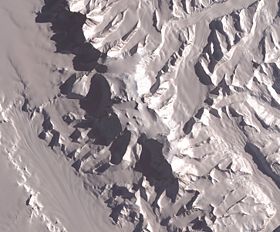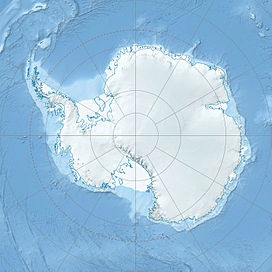- Vinson Massif
-
Vinson Massif 
NASA image of Vinson Massif from spaceElevation 4,892 m (16,050 ft) [1] Prominence 4,892 m (16,050 ft) [2]
Ranked 8thListing Seven summits
UltraLocation Antarctica Range Sentinel Range Coordinates 78°31′31.74″S 85°37′1.73″W / 78.5254833°S 85.6171472°WCoordinates: 78°31′31.74″S 85°37′1.73″W / 78.5254833°S 85.6171472°W[3] Climbing First ascent 1966 by Nicholas Clinch and party Easiest route snow/ice climb Vinson Massif (
 /ˈvɪnsən mæˈsiːf/) is the highest mountain of Antarctica, lying in the Sentinel Range of the Ellsworth Mountains, which stand above the Ronne Ice Shelf near the base of the Antarctic Peninsula. The massif is located about 1,200 kilometres (750 mi) from the South Pole and is about 21 km (13 mi) long and 13 km (8.1 mi) wide.[4] At 4,892 metres (16,050 ft) the highest point is Mount Vinson, which was named in 2006 after Carl Vinson, long-time member of the U.S. Congress from the state of Georgia.[5]
/ˈvɪnsən mæˈsiːf/) is the highest mountain of Antarctica, lying in the Sentinel Range of the Ellsworth Mountains, which stand above the Ronne Ice Shelf near the base of the Antarctic Peninsula. The massif is located about 1,200 kilometres (750 mi) from the South Pole and is about 21 km (13 mi) long and 13 km (8.1 mi) wide.[4] At 4,892 metres (16,050 ft) the highest point is Mount Vinson, which was named in 2006 after Carl Vinson, long-time member of the U.S. Congress from the state of Georgia.[5]Vinson Massif was first seen in 1958 and first climbed in 1966. An expedition in 2001 was the first to climb via the Eastern route, and also took GPS measurements of the height of the peak.[6] As of February 2010, 700 climbers have attempted to reach the top of Mount Vinson.[7]
Contents
Geography
The massif extends between Goodge Col and Branscomb Glacier to the northwest, Nimitz Glacier and Gildea Glacier to the southwest and south, Dater Glacier and its tributary Hinkley Glacier to the east. The southeastern part of the massif ends at Hammer Col, which joins it to the Craddock Massif, of which the highest point is Mount Rutford (4,477 metres / 14,688 feet). The massif comprises both the high central Vinson Plateau with its few peaks rising to over 4,700 metres (15,400 ft), and several side ridges mostly trending southwest or northeast from the plateau.
The current height (16,066 ft/4,897 m) resulted from a GPS survey by the 2004 Omega Foundation team comprising Damien Gildea of Australia (leader) and Rodrigo Fica and Camilo Rada of Chile.[8] Since 1998 and continuing through 2007, the Omega Foundation has placed a GPS receiver on the summit for a suitable period of time to obtain accurate satellite readings.[8]
Climate and glaciers
The climate on Vinson is generally controlled by the polar ice cap's high-pressure system, creating predominantly stable conditions but, as in any polar climate, high winds and snowfall are a possibility. Though the annual snowfall on Vinson is low, high winds can cause base camp accumulations up to 46 centimetres (18 in) in a year. During the summer season, November through January, there are 24 hours of sunlight. While the average temperature during these months is −30 °C (−20 °F), the intense sun will melt snow on dark objects.[citation needed]
Over successive years, the limited amount of snow that falls on Vinson Massif compacts and is transformed into ice, forming glaciers. These glaciers follow the topography and flow down the mountains valleys.[9] The uppermost glacier occupies the north face of Vinson, and flows either into Branscomb Glacier to the west or Crosswell Glacier to the east. The Crosswell Glacier flows into the Rutford Ice Stream via Ellen Glacier.[9]
History
A high mountain, provisionally known as 'Vinson', was long suspected to be in this part of West Antarctica, but it was not actually seen until January 1958, when it was spotted by US Navy aircraft from Byrd Station. It was named after Carl Vinson (also the namesake of an aircraft carrier), a United States Georgia Congressman who was a key supporter of funding for Antarctic research.[4] The first measurement of the Vinson Massif was established in 1959 at the elevation of 5,140 m (16,864 ft).[4]
First ascent
In 1963, two groups within the American Alpine Club, one led by Charles Hollister and Samuel C. Silverstein, M.D., then in New York, and the other led by Peter Schoening of Seattle, Washington, began lobbying the National Science Foundation to support an expedition to climb. The two groups merged in spring 1966 at the urging of the National Science Foundation and the American Alpine Club, and Nicholas Clinch (Pasadena, CA) was recruited by the American Alpine Club to lead the merged expeditions. Named officially the American Antarctic Mountaineering Expedition 1966/67, the expedition was sponsored by the American Alpine Club and the National Geographic Society, and supported in the field by the U.S. Navy and the National Science Foundation Office of Antarctic Programs. Ten scientists and mountaineers participated in AAME 1966/67. In addition to Clinch they were Barry Corbet (Jackson Hole, WY), John Evans (University of Minnesota, Minneapolis, MN), Eiichi Fukushima (University of Washington, Seattle, WA), Charles Hollister, Ph.D. (Columbia University, New York, NY), William Long, Ph.D. (Alaska Methodist University, Anchorage, AK), Brian Marts (Seattle, WA), Peter Schoening (Seattle, WA), Samuel Silverstein, M.D. (Rockefeller University, New York, NY) and Richard Wahlstrom (Seattle, WA).
In the months prior to its departure for Antarctica the expedition received considerable press attention, primarily because of the reports that Woodrow Wilson Sayre was planning to fly in a Piper Apache piloted by Max Conrad, the "flying Grandfather", with four companions into the Sentinel Range to climb the Vinson Massif. Sayre had a reputation for problematic trips as a result of his unauthorized, unsuccessful, and nearly fatal attempt to climb Mount Everest from the North in 1962. His unauthorized incursion into Tibet led China to file an official protest with the U.S. State Department. In the end, the purported race did not materialize as Conrad had difficulties with his plane. According to press reports, he and Sayre were still in Buenos Aires on the day the first four members of AAME 1966/67 reached Vinson's summit.
In December 1966 the Navy transported the expedition and its supplies from Christchurch, New Zealand to the U.S. base at McMurdo Sound, Antarctica, and from there in a ski-equipped C-130 Hercules to the Sentinel Range. All members of the expedition reached the summit of the Vinson Massif. The first group of four climbers summited on December 18, 1966, four more on December 19, and the last three on December 20.
On August 18, 2006, from nomination by Damien Gildea of the Omega Foundation, US-ACAN approved naming the subsidiary peaks south of Mt. Vinson for the AAME 1966/67 members Nicholas Clinch, Barry Corbet, Eiichi Fukushima, Charles Hollister, Brian Marts, Samuel Silverstein, Peter Schoening and Richard Wahlstrom. Other peaks in the Sentinel Range had previously been named for John Evans and William Long.[10]
Later ascents
The climb of Vinson offers little technical difficulty beyond the usual hazards of travel in Antarctica, and as one of the Seven Summits, it has received much attention from well-funded climbers in recent years.[11] Multiple guide companies offer guided expeditions to Vinson, at a typical cost of around $30,000 per person, including transportation to Antarctica from Chile. As of 2010, nearly 2000? people have summited Mount Vinson.
First ascent from east side
While the vast majority of prior climbs to the summit have used the western side of the massif from the Branscomb Glacier, the first ascent from the east side was successfully completed by an eight-person team sponsored by NOVA in January 2001.[6] The team consisted of:
- Conrad Anker - expedition leader
- Jon Krakauer - mountaineer and author
- Dave Hahn - mountain guide with 27 ascents, including ascents to Gardner, and Shinn.
- Andrew Mclean - extreme skier
- Dan Stone - glaciologist
- Lisel Clark - producer
- John Armstrong - cameraman
- Rob Raker - assistant cameraman and sound recording
The team not only made the first ascent from the east side but also performed scientific research into snow accumulation at different elevations as well as taking the first ground based GPS reading from the summit. The GPS reading gave the elevation of the highest point in Antarctica as 16,077 ft (4,900 m), eclipsing the earlier established heights recorded in 1959 and 1979.
Another first was the successful aircraft landing of a Twin Otter on the Upper Dater Glacier on the eastern slopes of Vinson Massif.
NOVA named the production "Mountain of Ice", which first aired on PBS in February 2003.[6]
See also
- Vinson Plateau
References
- ^ "Vinson Massif" Peakbagger.com. Retrieved 2011-10-26.
- ^ "Antartica - Ultra Prominences" peaklist.org. Retrieved 2011-10-26.
- ^ "GPS waypoints for the Vinson Massif". 7 Summits. http://7summits.com/vinson/waypoints.php. Retrieved 2007-01-29.
- ^ a b c "Vinson Massif". Geographic Names Information System, U.S. Geological Survey. http://geonames.usgs.gov/pls/gnispublic/f?p=gnispq:5:::NO::P5_ANTAR_ID:16082. Retrieved 2008-09-20.
- ^ "Mount Vinson". Geographic Names Information System, U.S. Geological Survey. http://geonames.usgs.gov/pls/gnispublic/f?p=gnispq:5:::NO::P5_ANTAR_ID:18890. Retrieved 2008-09-20.
- ^ a b c NOVA. "Mountain of Ice". WGBH. http://www.pbs.org/wgbh/nova/vinson/. Retrieved 2004-12-28.
- ^ "Suzanne sets a towering example for Arab women". Gulfnews.com. http://gulfnews.com/news/gulf/uae/general/suzanne-sets-a-towering-example-for-arab-women-1.585491.
- ^ a b Gildea, Damien; Splettstoesser, John (2007-08-27). "Craddock Massif and Vinson Massif remeasured". 10th International Symposium on Antarctic Earth Sciences (ISAES), 2007. http://isaes.confex.com/isaes/2007/techprogram/P1166.HTM. Retrieved 2008-09-20
- ^ a b "Vinson Massif". United States Geological Survey. http://usarc.usgs.gov/drgs/dir1/c78082s1.jpg.
- ^ ExplorersWeb Inc.. "Vinson Massif & The Sentinel Range: New map - new names". The Poles. http://www.thepoles.com/news.php?id=14995. Retrieved 2008-09-20.
- ^ "Mount Vinson, the summit of Antarctica". 7 Summits. 2008. http://7summits.com/vinson/vinson.htm. Retrieved 2008-09-20.
Seven Summits Asia Everest (8,848 m/29,029 ft)
South America Aconcagua (6,962 m/22,841 ft)
North America Mount McKinley (6,198 m/20,335 ft)
Africa Kilimanjaro (5,893 m/19,334 ft)
Europe Elbrus (5,642 m/18,510 ft) • or Mont Blanc (4,810 m/15,781 ft)
Antarctica Vinson Massif (4,892 m/16,050 ft)
Australia (Oceania) Puncak Jaya (4,884 m/16,024 ft) • or Mount Wilhelm (4,509 m/14,793 ft) • or Mount Kosciuszko (2,228 m/7,310 ft)
Categories:- Mountains of Antarctica
- Seven Summits
- Ellsworth Mountains
- Filchner-Ronne Ice Shelf
Wikimedia Foundation. 2010.


